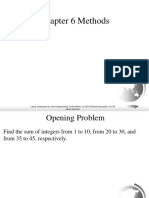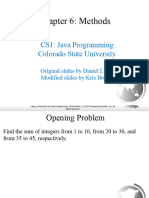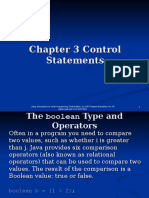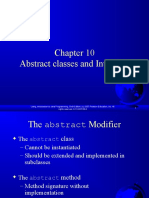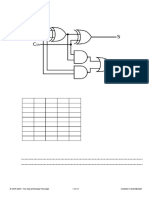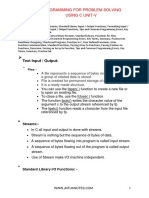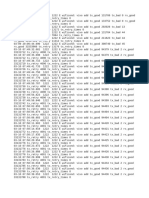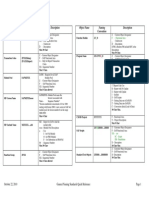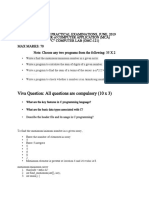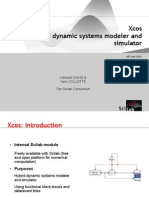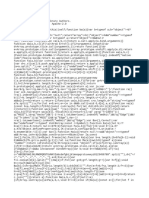Chapter 5 Methods
Liang, Introduction to Java Programming, Sixth Edition, (c) 2007 Pearson Education, Inc. All rig
hts reserved. 0-13-222158-6
Introducing Methods
A method is a collection of statements that are
grouped together to perform an operation.
Define a method
modifier
method
header
return value type
Invoke a method
method name
formal parameters
public static int max(int num1, int num2) {
int z = max(x, y);
int result;
method
body
if (num1 > num2)
result = num1;
else
result = num2;
}
parameter list
actual parameters
(arguments)
return value
return result;
Liang, Introduction to Java Programming, Sixth Edition, (c) 2007 Pearson Education, Inc. All rig
hts reserved. 0-13-222158-6
Introducing Methods, cont.
Method signature is the combination of the
method name and the parameter list.
The variables defined in the method header are
known as formal parameters.
When a method is invoked, you pass a value to
the parameter. This value is referred to as actual
parameter or argument.
Liang, Introduction to Java Programming, Sixth Edition, (c) 2007 Pearson Education, Inc. All rig
hts reserved. 0-13-222158-6
Introducing Methods, cont.
A method may return a value. The
returnValueType is the data type of the value the
method returns. If the method does not return a
value, the returnValueType is the keyword void.
For example, the returnValueType in the main
method is void.
Liang, Introduction to Java Programming, Sixth Edition, (c) 2007 Pearson Education, Inc. All rig
hts reserved. 0-13-222158-6
Calling Methods
Listing 5.1 Testing the max method
This program demonstrates calling a method max
to return the largest of the int values
TestMax
Liang, Introduction to Java Programming, Sixth Edition, (c) 2007 Pearson Education, Inc. All rig
hts reserved. 0-13-222158-6
animation
Calling Methods, cont.
pass the value of i
public static void main(String[] args) {
int i = 5;
int j = 2;
int k = max(i, j);
pass the value of j
public static int max(int num1, int num2) {
int result;
if (num1 > num2)
result = num1;
else
result = num2;
System.out.println(
"The maximum between " + i +
" and " + j + " is " + k);
}
return result;
Liang, Introduction to Java Programming, Sixth Edition, (c) 2007 Pearson Education, Inc. All rig
hts reserved. 0-13-222158-6
animation
Trace Method Invocation
i is now 5
publicstaticvoidmain(String[]args){
inti=5;
intj=2;
intk=max(i,j);
System.out.println(
"Themaximumbetween"+i+
"and"+j+"is"+k);
}
publicstaticintmax(intnum1,intnum2){
intresult;
if(num1>num2)
result=num1;
else
result=num2;
returnresult;
}
Liang, Introduction to Java Programming, Sixth Edition, (c) 2007 Pearson Education, Inc. All rig
hts reserved. 0-13-222158-6
animation
Trace Method Invocation
j is now 2
publicstaticvoidmain(String[]args){
inti=5;
intj=2;
intk=max(i,j);
System.out.println(
"Themaximumbetween"+i+
"and"+j+"is"+k);
}
publicstaticintmax(intnum1,intnum2){
intresult;
if(num1>num2)
result=num1;
else
result=num2;
returnresult;
}
Liang, Introduction to Java Programming, Sixth Edition, (c) 2007 Pearson Education, Inc. All rig
hts reserved. 0-13-222158-6
animation
Trace Method Invocation
invoke max(i, j)
publicstaticvoidmain(String[]args){
inti=5;
intj=2;
intk=max(i,j);
System.out.println(
"Themaximumbetween"+i+
"and"+j+"is"+k);
}
publicstaticintmax(intnum1,intnum2){
intresult;
if(num1>num2)
result=num1;
else
result=num2;
returnresult;
}
Liang, Introduction to Java Programming, Sixth Edition, (c) 2007 Pearson Education, Inc. All rig
hts reserved. 0-13-222158-6
animation
Trace Method Invocation
invoke max(i, j)
Pass the value of i to num1
Pass the value of j to num2
publicstaticvoidmain(String[]args){
inti=5;
intj=2;
intk=max(i,j);
System.out.println(
"Themaximumbetween"+i+
"and"+j+"is"+k);
}
publicstaticintmax(intnum1,intnum2){
intresult;
if(num1>num2)
result=num1;
else
result=num2;
returnresult;
}
Liang, Introduction to Java Programming, Sixth Edition, (c) 2007 Pearson Education, Inc. All rig
hts reserved. 0-13-222158-6
10
animation
Trace Method Invocation
declare variable result
publicstaticvoidmain(String[]args){
inti=5;
intj=2;
intk=max(i,j);
System.out.println(
"Themaximumbetween"+i+
"and"+j+"is"+k);
}
publicstaticintmax(intnum1,intnum2){
intresult;
if(num1>num2)
result=num1;
else
result=num2;
returnresult;
}
Liang, Introduction to Java Programming, Sixth Edition, (c) 2007 Pearson Education, Inc. All rig
hts reserved. 0-13-222158-6
11
animation
Trace Method Invocation
(num1 > num2) is true since
num1 is 5 and num2 is 2
publicstaticvoidmain(String[]args){
inti=5;
intj=2;
intk=max(i,j);
System.out.println(
"Themaximumbetween"+i+
"and"+j+"is"+k);
}
publicstaticintmax(intnum1,intnum2){
intresult;
if(num1>num2)
result=num1;
else
result=num2;
returnresult;
}
Liang, Introduction to Java Programming, Sixth Edition, (c) 2007 Pearson Education, Inc. All rig
hts reserved. 0-13-222158-6
12
animation
Trace Method Invocation
result is now 5
publicstaticvoidmain(String[]args){
inti=5;
intj=2;
intk=max(i,j);
System.out.println(
"Themaximumbetween"+i+
"and"+j+"is"+k);
}
publicstaticintmax(intnum1,intnum2){
intresult;
if(num1>num2)
result=num1;
else
result=num2;
returnresult;
}
Liang, Introduction to Java Programming, Sixth Edition, (c) 2007 Pearson Education, Inc. All rig
hts reserved. 0-13-222158-6
13
animation
Trace Method Invocation
return result, which is 5
publicstaticvoidmain(String[]args){
inti=5;
intj=2;
intk=max(i,j);
System.out.println(
"Themaximumbetween"+i+
"and"+j+"is"+k);
}
publicstaticintmax(intnum1,intnum2){
intresult;
if(num1>num2)
result=num1;
else
result=num2;
returnresult;
}
Liang, Introduction to Java Programming, Sixth Edition, (c) 2007 Pearson Education, Inc. All rig
hts reserved. 0-13-222158-6
14
animation
Trace Method Invocation
return max(i, j) and assign the
return value to k
publicstaticvoidmain(String[]args){
inti=5;
intj=2;
intk=max(i,j);
System.out.println(
"Themaximumbetween"+i+
"and"+j+"is"+k);
}
publicstaticintmax(intnum1,intnum2){
intresult;
if(num1>num2)
result=num1;
else
result=num2;
returnresult;
}
Liang, Introduction to Java Programming, Sixth Edition, (c) 2007 Pearson Education, Inc. All rig
hts reserved. 0-13-222158-6
15
animation
Trace Method Invocation
Execute the print statement
publicstaticvoidmain(String[]args){
inti=5;
intj=2;
intk=max(i,j);
System.out.println(
"Themaximumbetween"+i+
"and"+j+"is"+k);
}
publicstaticintmax(intnum1,intnum2){
intresult;
if(num1>num2)
result=num1;
else
result=num2;
returnresult;
}
Liang, Introduction to Java Programming, Sixth Edition, (c) 2007 Pearson Education, Inc. All rig
hts reserved. 0-13-222158-6
16
CAUTION
A return statement is required for a nonvoid
method. The following method is logically
correct, but it has a compilation error, because the
Java compiler thinks it possible that this method
does not return any value.
public static int sign(int n) {
if (n > 0) return 1;
else if (n == 0) return 0;
else if (n < 0) return 1;
}
To fix this problem, delete if (n<0) in the code.
Liang, Introduction to Java Programming, Sixth Edition, (c) 2007 Pearson Education, Inc. All rig
hts reserved. 0-13-222158-6
17
Reuse Methods from Other Classes
NOTE: One of the benefits of methods is for reuse. The max
method can be invoked from any class besides TestMax. If
you create a new class Test, you can invoke the max method
using ClassName.methodName (e.g., TestMax.max).
Liang, Introduction to Java Programming, Sixth Edition, (c) 2007 Pearson Education, Inc. All rig
hts reserved. 0-13-222158-6
18
Call Stacks
Space required for the
max method
result: 5
num2: 2
num1: 5
Space required for the
main method
k:
j: 2
i: 5
The main method
is invoked.
Space required for the
main method
k:
j: 2
i: 5
Space required for the
main method
k: 5
j: 2
i: 5
The max method is
invoked.
The max method is
finished and the return
value is sent to k.
Liang, Introduction to Java Programming, Sixth Edition, (c) 2007 Pearson Education, Inc. All rig
hts reserved. 0-13-222158-6
Stack is empty
The main method
is finished.
19
animation
Trace Call Stack
i is declared and initialized
publicstaticvoidmain(String[]args){
inti=5;
intj=2;
intk=max(i,j);
System.out.println(
"Themaximumbetween"+i+
"and"+j+"is"+k);
}
publicstaticintmax(intnum1,intnum2){
intresult;
if(num1>num2)
result=num1;
else
result=num2;
returnresult;
}
i: 5
The main method
is invoked.
Liang, Introduction to Java Programming, Sixth Edition, (c) 2007 Pearson Education, Inc. All rig
hts reserved. 0-13-222158-6
20
animation
Trace Call Stack
j is declared and initialized
publicstaticvoidmain(String[]args){
inti=5;
intj=2;
intk=max(i,j);
System.out.println(
"Themaximumbetween"+i+
"and"+j+"is"+k);
}
publicstaticintmax(intnum1,intnum2){
intresult;
if(num1>num2)
result=num1;
else
result=num2;
returnresult;
}
j: 2
i: 5
The main method
is invoked.
Liang, Introduction to Java Programming, Sixth Edition, (c) 2007 Pearson Education, Inc. All rig
hts reserved. 0-13-222158-6
21
animation
Trace Call Stack
Declare k
publicstaticvoidmain(String[]args){
inti=5;
intj=2;
intk=max(i,j);
System.out.println(
"Themaximumbetween"+i+
"and"+j+"is"+k);
}
publicstaticintmax(intnum1,intnum2){
intresult;
if(num1>num2)
result=num1;
else
result=num2;
returnresult;
}
Space required for the
main method
k:
j: 2
i: 5
The main method
is invoked.
Liang, Introduction to Java Programming, Sixth Edition, (c) 2007 Pearson Education, Inc. All rig
hts reserved. 0-13-222158-6
22
animation
Trace Call Stack
Invoke max(i, j)
publicstaticvoidmain(String[]args){
inti=5;
intj=2;
intk=max(i,j);
System.out.println(
"Themaximumbetween"+i+
"and"+j+"is"+k);
}
publicstaticintmax(intnum1,intnum2){
intresult;
if(num1>num2)
result=num1;
else
result=num2;
returnresult;
}
Space required for the
main method
k:
j: 2
i: 5
The main method
is invoked.
Liang, Introduction to Java Programming, Sixth Edition, (c) 2007 Pearson Education, Inc. All rig
hts reserved. 0-13-222158-6
23
animation
Trace Call Stack
pass the values of i and j to num1
and num2
publicstaticvoidmain(String[]args){
inti=5;
intj=2;
intk=max(i,j);
System.out.println(
"Themaximumbetween"+i+
"and"+j+"is"+k);
}
publicstaticintmax(intnum1,intnum2){
intresult;
if(num1>num2)
result=num1;
else
result=num2;
returnresult;
}
num2: 2
num1: 5
Space required for the
main method
k:
j: 2
i: 5
The max method is
invoked.
Liang, Introduction to Java Programming, Sixth Edition, (c) 2007 Pearson Education, Inc. All rig
hts reserved. 0-13-222158-6
24
animation
Trace Call Stack
pass the values of i and j to num1
and num2
publicstaticvoidmain(String[]args){
inti=5;
intj=2;
intk=max(i,j);
System.out.println(
"Themaximumbetween"+i+
"and"+j+"is"+k);
}
publicstaticintmax(intnum1,intnum2){
intresult;
if(num1>num2)
result=num1;
else
result=num2;
returnresult;
}
result:
num2: 2
num1: 5
Space required for the
main method
k:
j: 2
i: 5
The max method is
invoked.
Liang, Introduction to Java Programming, Sixth Edition, (c) 2007 Pearson Education, Inc. All rig
hts reserved. 0-13-222158-6
25
animation
Trace Call Stack
(num1 > num2) is true
publicstaticvoidmain(String[]args){
inti=5;
intj=2;
intk=max(i,j);
System.out.println(
"Themaximumbetween"+i+
"and"+j+"is"+k);
}
publicstaticintmax(intnum1,intnum2){
intresult;
if(num1>num2)
result=num1;
else
result=num2;
returnresult;
}
result:
num2: 2
num1: 5
Space required for the
main method
k:
j: 2
i: 5
The max method is
invoked.
Liang, Introduction to Java Programming, Sixth Edition, (c) 2007 Pearson Education, Inc. All rig
hts reserved. 0-13-222158-6
26
animation
Trace Call Stack
Assign num1 to result
publicstaticvoidmain(String[]args){
inti=5;
intj=2;
intk=max(i,j);
System.out.println(
"Themaximumbetween"+i+
"and"+j+"is"+k);
}
publicstaticintmax(intnum1,intnum2){
intresult;
if(num1>num2)
result=num1;
else
result=num2;
returnresult;
}
Space required for the
max method
result: 5
num2: 2
num1: 5
Space required for the
main method
k:
j: 2
i: 5
The max method is
invoked.
Liang, Introduction to Java Programming, Sixth Edition, (c) 2007 Pearson Education, Inc. All rig
hts reserved. 0-13-222158-6
27
animation
Trace Call Stack
Return result and assign it to k
publicstaticvoidmain(String[]args){
inti=5;
intj=2;
intk=max(i,j);
System.out.println(
"Themaximumbetween"+i+
"and"+j+"is"+k);
}
publicstaticintmax(intnum1,intnum2){
intresult;
if(num1>num2)
result=num1;
else
result=num2;
returnresult;
}
Space required for the
max method
result: 5
num2: 2
num1: 5
Space required for the
main method
k:5
j: 2
i: 5
The max method is
invoked.
Liang, Introduction to Java Programming, Sixth Edition, (c) 2007 Pearson Education, Inc. All rig
hts reserved. 0-13-222158-6
28
animation
Trace Call Stack
Execute print statement
publicstaticvoidmain(String[]args){
inti=5;
intj=2;
intk=max(i,j);
System.out.println(
"Themaximumbetween"+i+
"and"+j+"is"+k);
}
publicstaticintmax(intnum1,intnum2){
intresult;
if(num1>num2)
result=num1;
else
result=num2;
returnresult;
}
Space required for the
main method
k:5
j: 2
i: 5
The main method
is invoked.
Liang, Introduction to Java Programming, Sixth Edition, (c) 2007 Pearson Education, Inc. All rig
hts reserved. 0-13-222158-6
29
Passing Parameters
public static void nPrintln(String message, int n) {
for (int i = 0; i < n; i++)
System.out.println(message);
}
Suppose you invoke the method using
nPrintln(Welcome to Java, 5);
What is the output?
Suppose you invoke the method using
nPrintln(Computer Science, 15);
What is the output?
Liang, Introduction to Java Programming, Sixth Edition, (c) 2007 Pearson Education, Inc. All rig
hts reserved. 0-13-222158-6
30
Pass by Value
Listing 5.2 Testing Pass by value
This program demonstrates passing values
to the methods.
TestPassByValue
Liang, Introduction to Java Programming, Sixth Edition, (c) 2007 Pearson Education, Inc. All rig
hts reserved. 0-13-222158-6
31
Pass by Value, cont.
The values of num1 and num2 are
passed to n1 and n2. Executing swap
does not affect num1 and num2.
Space required for the
swap method
temp:
n2: 2
n1: 1
Space required for the
main method
num2: 2
num1: 1
The main method
is invoked
Space required for the
main method
num2: 2
num1: 1
The swap method
is invoked
Space required for the
main method
num2: 2
num1: 1
The swap method
is finished
Liang, Introduction to Java Programming, Sixth Edition, (c) 2007 Pearson Education, Inc. All rig
hts reserved. 0-13-222158-6
Stack is empty
The main method
is finished
32
Overloading Methods
Listing 5.3 Overloading the max Method
public static double max(double num1, double
num2) {
if (num1 > num2)
return num1;
else
return num2;
}
TestMethodOverloading
Liang, Introduction to Java Programming, Sixth Edition, (c) 2007 Pearson Education, Inc. All rig
hts reserved. 0-13-222158-6
33
Ambiguous Invocation
Sometimes there may be two or more
possible matches for an invocation of a
method, but the compiler cannot determine
the most specific match. This is referred to
as ambiguous invocation. Ambiguous
invocation is a compilation error.
Liang, Introduction to Java Programming, Sixth Edition, (c) 2007 Pearson Education, Inc. All rig
hts reserved. 0-13-222158-6
34
Ambiguous Invocation
public class AmbiguousOverloading {
public static void main(String[] args) {
System.out.println(max(1, 2));
}
public static double max(int num1, double num2) {
if (num1 > num2)
return num1;
else
return num2;
}
public static double max(double num1, int num2) {
if (num1 > num2)
return num1;
else
return num2;
}
}
Liang, Introduction to Java Programming, Sixth Edition, (c) 2007 Pearson Education, Inc. All rig
hts reserved. 0-13-222158-6
35
Scope of Local Variables
A local variable: a variable defined inside a
method.
Scope: the part of the program where the
variable can be referenced.
The scope of a local variable starts from its
declaration and continues to the end of the
block that contains the variable. A local
variable must be declared before it can be
used.
Liang, Introduction to Java Programming, Sixth Edition, (c) 2007 Pearson Education, Inc. All rig
hts reserved. 0-13-222158-6
36
Scope of Local Variables, cont.
You can declare a local variable with the
same name multiple times in different nonnesting blocks in a method, but you cannot
declare a local variable twice in nested
blocks.
Liang, Introduction to Java Programming, Sixth Edition, (c) 2007 Pearson Education, Inc. All rig
hts reserved. 0-13-222158-6
37
Scope of Local Variables, cont.
A variable declared in the initial action part of a for loop
header has its scope in the entire loop. But a variable
declared inside a for loop body has its scope limited in the
loop body from its declaration and to the end of the block
that contains the variable.
The scope of i
The scope of j
public static void method1() {
.
.
for (int i = 1; i < 10; i++) {
.
.
int j;
.
.
.
}
}
Liang, Introduction to Java Programming, Sixth Edition, (c) 2007 Pearson Education, Inc. All rig
hts reserved. 0-13-222158-6
38
Scope of Local Variables, cont.
Itisfinetodeclareiintwo
nonnestingblocks
publicstaticvoidmethod1(){
intx=1;
inty=1;
for(inti=1;i<10;i++){
x+=i;
}
for(inti=1;i<10;i++){
y+=i;
}
}
Itiswrongtodeclareiin
twonestingblocks
publicstaticvoidmethod2(){
inti=1;
intsum=0;
for(inti=1;i<10;i++){
sum+=i;
}
Liang, Introduction to Java Programming, Sixth Edition, (c) 2007 Pearson Education, Inc. All rig
hts reserved. 0-13-222158-6
39
Scope of Local Variables, cont.
// Fine with no errors
public static void correctMethod() {
int x = 1;
int y = 1;
// i is declared
for (int i = 1; i < 10; i++) {
x += i;
}
// i is declared again
for (int i = 1; i < 10; i++) {
y += i;
}
}
Liang, Introduction to Java Programming, Sixth Edition, (c) 2007 Pearson Education, Inc. All rig
hts reserved. 0-13-222158-6
40
Scope of Local Variables, cont.
// With no errors
public static void incorrectMethod() {
int x = 1;
int y = 1;
for (int i = 1; i < 10; i++) {
int x = 0;
x += i;
}
}
Liang, Introduction to Java Programming, Sixth Edition, (c) 2007 Pearson Education, Inc. All rig
hts reserved. 0-13-222158-6
41
Method Abstraction
You can think of the method body as a black box
that contains the detailed implementation for the
method.
Optional arguments
for Input
Optional return
value
Method Signature
Method body
Black Box
Liang, Introduction to Java Programming, Sixth Edition, (c) 2007 Pearson Education, Inc. All rig
hts reserved. 0-13-222158-6
42
Benefits of Methods
Write a method once and reuse it anywhere.
Information hiding. Hide the implementation
from the user.
Reduce complexity.
Liang, Introduction to Java Programming, Sixth Edition, (c) 2007 Pearson Education, Inc. All rig
hts reserved. 0-13-222158-6
43
The Math Class
Class constants:
PI
E
Class methods:
Trigonometric Methods
Exponent Methods
Rounding Methods
min, max, abs, and random Methods
Liang, Introduction to Java Programming, Sixth Edition, (c) 2007 Pearson Education, Inc. All rig
hts reserved. 0-13-222158-6
44
Trigonometric Methods
sin(double a)
cos(double a)
tan(double a)
acos(double a)
asin(double a)
atan(double a)
Examples:
Math.sin(0) returns 0.0
Math.sin(Math.PI / 6)
returns 0.5
Math.sin(Math.PI / 2)
returns 1.0
Math.cos(0) returns 1.0
Math.cos(Math.PI / 6)
returns 0.866
Math.cos(Math.PI / 2)
returns 0
Liang, Introduction to Java Programming, Sixth Edition, (c) 2007 Pearson Education, Inc. All rig
hts reserved. 0-13-222158-6
45
Exponent Methods
exp(double a)
Returns e raised to the power of a.
log(double a)
Returns the natural logarithm of a.
log10(double a)
Returns the 10-based logarithm of
a.
pow(double a, double b)
Returns a raised to the power of b.
sqrt(double a)
Returns the square root of a.
Examples:
Math.exp(1) returns 2.71
Math.log(2.71) returns 1.0
Math.pow(2, 3) returns 8.0
Math.pow(3, 2) returns 9.0
Math.pow(3.5, 2.5) returns
22.91765
Math.sqrt(4) returns 2.0
Math.sqrt(10.5) returns 3.24
Liang, Introduction to Java Programming, Sixth Edition, (c) 2007 Pearson Education, Inc. All rig
hts reserved. 0-13-222158-6
46
Rounding Methods
double ceil(double x)
x rounded up to its nearest integer. This integer is returned as a
double value.
double floor(double x)
x is rounded down to its nearest integer. This integer is returned as a
double value.
double rint(double x)
x is rounded to its nearest integer. If x is equally close to two integers,
the even one is returned as a double.
int round(float x)
Return (int)Math.floor(x+0.5).
long round(double x)
Return (long)Math.floor(x+0.5).
Liang, Introduction to Java Programming, Sixth Edition, (c) 2007 Pearson Education, Inc. All rig
hts reserved. 0-13-222158-6
47
Rounding Methods Examples
Math.ceil(2.1) returns 3.0
Math.ceil(2.0) returns 2.0
Math.ceil(-2.0) returns 2.0
Math.ceil(-2.1) returns -2.0
Math.floor(2.1) returns 2.0
Math.floor(2.0) returns 2.0
Math.floor(-2.0) returns 2.0
Math.floor(-2.1) returns -3.0
Math.rint(2.1) returns 2.0
Math.rint(2.0) returns 2.0
Math.rint(-2.0) returns 2.0
Math.rint(-2.1) returns -2.0
Math.rint(2.5) returns 2.0
Math.rint(-2.5) returns -2.0
Math.round(2.6f) returns 3
Math.round(2.0) returns 2
Math.round(-2.0f) returns -2
Math.round(-2.6) returns -3
Liang, Introduction to Java Programming, Sixth Edition, (c) 2007 Pearson Education, Inc. All rig
hts reserved. 0-13-222158-6
48
min, max, and abs
max(a, b)and min(a, b)
Returns the maximum or
minimum of two parameters.
abs(a)
Returns the absolute value of the
parameter.
random()
Returns a random double value
in the range [0.0, 1.0).
Examples:
Math.max(2, 3) returns 3
Math.max(2.5, 3) returns
3.0
Math.min(2.5, 3.6)
returns 2.5
Math.abs(-2) returns 2
Math.abs(-2.1) returns
2.1
Liang, Introduction to Java Programming, Sixth Edition, (c) 2007 Pearson Education, Inc. All rig
hts reserved. 0-13-222158-6
49
The random Method
Generates a random double value greater than or equal to 0.0 and less
than 1.0 (0 <= Math.random() < 1.0).
Examples:
(int)(Math.random() * 10)
Returns a random integer
between 0 and 9.
50 + (int)(Math.random() * 50)
Returns a random integer
between 50 and 99.
In general,
a + Math.random() * b
Returns a random number between
a and a + b, excluding a + b.
Liang, Introduction to Java Programming, Sixth Edition, (c) 2007 Pearson Education, Inc. All rig
hts reserved. 0-13-222158-6
50
JBuilder
Optional
View java.lang.Math Documentation
You can view the complete
documentation for the Math
class online from
http://java.sun.com/j2se/1.5.
2/docs/api/index.htm.
Liang, Introduction to Java Programming, Sixth Edition, (c) 2007 Pearson Education, Inc. All rig
hts reserved. 0-13-222158-6
51



